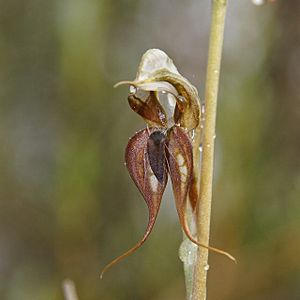Large-lipped rustyhood facts for kids
Quick facts for kids Large-lipped rustyhood |
|
|---|---|
 |
|
| Pterostylis lingua growing near Werrimull | |
| Scientific classification | |
| Genus: |
Pterostylis
|
| Species: |
lingua
|
| Synonyms | |
|
Oligochaetochilus linguus (M.A.Clem.) Szlach. |
|
Pterostylis lingua, commonly known as the large-lipped rustyhood, is a special type of orchid plant. It grows only in south-eastern Australia. This orchid has a group of leaves at its base, called a rosette. It also has unique dark reddish-brown flowers. These flowers have clear "windows" and a blackish part that looks like an insect.
Contents
About the Large-Lipped Rustyhood Orchid
The large-lipped rustyhood is a terrestrial plant, meaning it grows in the ground. It is also a perennial herb, which means it lives for more than two years and has soft stems. This plant grows from an underground tuber, which is like a small storage organ. It is also deciduous, so its leaves fall off at certain times.
What the Plant Looks Like
Each plant has a rosette of three to twelve oval-shaped leaves at its base. These leaves are about 10–35 mm (0.4–1 in) long and 8–12 mm (0.3–0.5 in) wide.
The plant grows a flowering stem that is 150–350 mm (6–10 in) tall. This stem can hold up to ten dark reddish-brown flowers. Each flower is about 25–32 mm (0.98–1.3 in) long and 8–11 mm (0.3–0.4 in) wide. The flowers have parts that are see-through, like little windows. There are also four to seven leaves wrapped around the flowering stem.
Flower Parts and Features
The top part of the flower, called the dorsal sepal, and the petals form a hood over the flower's center. This hood is called a "galea." The dorsal sepal has a tip that points upwards, about 5–8 mm (0.2–0.3 in) long.
The lateral sepals are the side parts of the flower. They point downwards and are wider than the galea. They narrow suddenly into tips that are 10–12 mm (0.4–0.5 in) long and spread apart.
The most interesting part is the labellum. It is blackish-brown, thin, and looks like an insect. It is about 6–7 mm (0.2–0.3 in) long and 3 mm (0.1 in) wide. The thicker "head" end of the labellum has many short hairs. The "body" part has seven to ten longer hairs on each side. These features help to attract insects for pollination.
When it Flowers
The large-lipped rustyhood orchid blooms during spring, usually from September to October.
How it Got its Name
The scientific name Pterostylis lingua was first officially described in 1989. This was done by a scientist named Mark Clements. He found a sample of the plant in the Cocoparra National Park. The description was then published in a scientific book called Australian Orchid Research.
The second part of its name, lingua, is a Latin word. It means "tongue," which likely refers to the shape of the labellum.
Where the Orchid Lives
The large-lipped rustyhood orchid grows in drier forests and woodlands. It is quite common in some areas between Cootamundra and Bourke in New South Wales.
In South Australia, this orchid is only found in a specific area called the Eastern Bioregion. In Victoria, it grows only in the far north-western part of the state.
Protecting the Large-Lipped Rustyhood
This orchid is considered "endangered" in both Victoria and South Australia. This means there are not many of these plants left, and they are at risk of disappearing. In Victoria, only about 1500 plants of Pterostylis lingua are known to exist. Efforts are being made to protect these special orchids.

